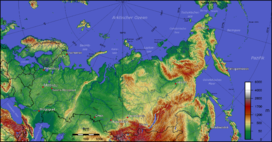Middle Urals
| The Ural Mountains | |
|---|---|
| Highest point | |
| Peak | Mount Narodnaya |
| Elevation | 1,895 m (6,217 ft) |
| Dimensions | |
| Length | 2,500 km (1,600 mi) |
| Width | 150 km (93 mi) |
| Geography | |
| Countries | Russia and Kazakhstan |
| Geology | |
| Age of rock | Carboniferous |
The Ural Mountains (Russian: Ура́льские го́ры, tr. Uralskiye gory; IPA: [ʊˈralʲskʲɪjə ˈgorɨ]; Bashkir: Урал тауҙары, Ural tauźarı), or simply the Urals, are a mountain range that runs approximately from north to south through western Russia, from the coast of the Arctic Ocean to the Ural River and northwestern Kazakhstan. The mountain range forms part of the conventional boundary between the continents of Europe and Asia. Vaygach Island and the islands of Novaya Zemlya form a further continuation of the chain to the north into the Arctic Ocean.
The mountains lie within the Ural geographical region and significantly overlap with the Ural Federal District and with the Ural economic region. They have rich resources, including metal ores, coal, precious and semi-precious stones. Since the 18th century the mountains have contributed significantly to the mineral sector of the Russian economy.
As attested by Sigismund von Herberstein, in the 16th century Russians called the range by a variety of names derived from the Russian words for rock (stone) and belt. The modern Russian name for the Urals (Урал, Ural), first appearing in the 16th–17th century when the Russian conquest of Siberia was in its heroic phase, was initially applied to its southern parts and gained currency as the name of the entire range during the 18th century. It might have been a borrowing from either Turkic "stone belt" (Bashkir, where the same name is used for the range), or Ob-Ugric. From the 13th century, in Bashkortostan there has been a legend about a hero named Ural. He sacrificed his life for the sake of his people and they poured a stone pile over his grave, which later turned into the Ural Mountains. Possibilities include Bashkir үр "elevation; upland"" or Mansi ур ала "mountain peak, top of the mountain", Ostyak urr (chain of mountains).V.N. Tatischev believes that this oronym is set to "belt" and associates it with the Turkic verb oralu- "gird". I.G. Dobrodomov suggests a transition from Aral to Ural explained on the basis of ancient Bulgar-Chuvash dialects. Geographer E.V. Hawks believes that the name goes back to the Bashkir folklore Ural-Batyr. Ethnographer E.N. Shumilov suggested a Mongolian origin, Khural Uul, that is, "meeting of the mountains". The Evenk geographical term era "mountain" has also been theorized. Finno-Ugrist scholars consider Ural deriving from the Mansi word 'urr' meaning a mountain. Turkologists, on the other hand, have achieved majority support for their assertion that 'ural' in Tatar means a belt, and recall that an earlier name for the range was 'stone belt'.
...
Wikipedia

